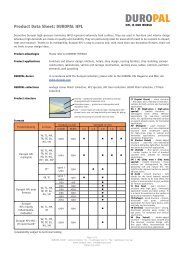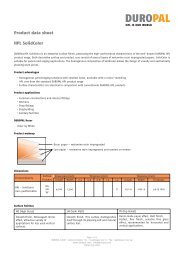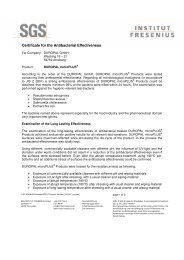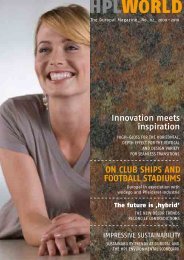duropal - Hpl- tecHno- loGY
duropal - Hpl- tecHno- loGY
duropal - Hpl- tecHno- loGY
You also want an ePaper? Increase the reach of your titles
YUMPU automatically turns print PDFs into web optimized ePapers that Google loves.
c) CONTACT ADHESIVES<br />
Without hardener: When applying with a stopping knife, the direction of application on<br />
the core material and laminate should be at right angles to each other. A brush or spraying<br />
or casting system may also be used for application. Whatever your choice, do take the<br />
greatest care when processing and ensure that there is adequate ventilation. Contact<br />
adhesives require short, firm pressure. The open time can be reduced by accelerating the<br />
drying of the adhesive films, but do make sure not to over-dry. Dried-on adhesive can be<br />
removed by heat, e.g. infrared rays. The pressure process is as follows.<br />
With hardener: This adhesive makes the joint suitable for greater stresses and more<br />
resistance to temperatures. For further information please consult the manufacturer.<br />
d) MIXED ADHESIVES<br />
We are unable to provide general recommendation for processing since this category is<br />
divided into various types, and is only used for special bonding applications.<br />
e) HOT MELT ADHESIVES<br />
Used mainly on edging.<br />
7.6.5 Postforming<br />
THE CORE MATERIAL<br />
It is important to choose a material in which the chips have the same thickness or size<br />
throughout, such as chipboard or MDF. Coarse chips in the middle layer of the chipboard may<br />
cause the HPL to crack or tear, depending on the quality of the milling<br />
PROFILE MILLING<br />
Ensure that the transitions between round and flat areas on the profile are even and that all<br />
cuts are smooth and clean. The radius of a postformed product is defined as the radius of the<br />
profiled core material.<br />
CONDITIONING<br />
Please observe the recommendations for storage and pre-treating. The postforming results<br />
may be adversely affected if not, especially if the environment is too dry.<br />
BONDING METHODS FOR POSTFORMING AND COATING<br />
In order to prevent tears and cracks, all traces of adhesive must be removed. This is particulary<br />
essential at the transition between rounded and flat areas. The same special adhesive, e.g.<br />
PVAc glue or contact adhesive, is to be used for Duropal-HPL and the balancer.<br />
PROCESS BASED ON THE SYSTEM CONFIGURATION (EXAMPLE)<br />
The continuous process consists of the following steps:<br />
- Cut and profile mill the core material<br />
- Compress the Duropal-HPL (standard type P = postformable) and balancer<br />
- Router the edges of the balancer<br />
– Apply adhesive to the underside and edge of the Duropal-HPL (approx. 120–180 g/m 2 )<br />
- Postform at 160-210°C. It is advisable to test first. If postforming continuously, the feed<br />
speed should be 11-17 m/min.<br />
- Use a coarse cutter to remove any projecting Duropal-HPL, then finish with a fine cutter<br />
at an angle of approx. 30°.<br />
_ 32










